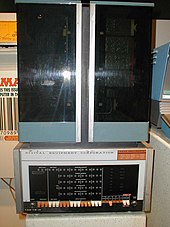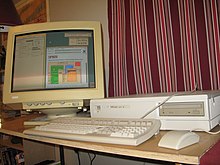Digital Equipment Corporation
Although a number of competitors had successfully competed with Digital through the 1970s, the VAX cemented the company's place as a leading vendor in the computer space.After several attempts to enter the workstation and file server market, the DEC Alpha product line began to make successful inroads in the mid-1990s, but was too late to save the company.[5] Instead, this effort evolved into the SAGE system for the US Air Force, which used large screens and light guns to allow operators to interact with radar data stored in the computer.[6] When the Air Force project wound down, the Lab turned their attention to an effort to build a version of the Whirlwind using transistors in place of vacuum tubes.[8] At MIT, Ken Olsen and Harlan Anderson noticed something odd: students would line up for hours to get a turn to use the stripped-down TX-0, while largely ignoring a faster IBM machine that was also available.[9][dead link][better source needed] In 1957, when the pair and Ken's brother Stan sought capital, they found that the American business community was hostile to investing in computer companies.They would start by selling computer modules as stand-alone devices that could be purchased separately and wired together to produce a number of different digital systems for lab use.[10] The newly christened "Digital Equipment Corporation" received $70,000 from AR&D for a 70% share of the company,[9][dead link][better source needed] and began operations in a Civil War-era textile mill in Maynard, Massachusetts, where plenty of inexpensive manufacturing space was available.Most systems were purchased with two peripherals, the Type 30 vector graphics display, and a Soroban Engineering modified IBM Model B Electric typewriter that was used as a printer.In 1962, Lincoln Laboratory used a selection of System Building Blocks to implement a small 12-bit machine, and attached it to a variety of analog-to-digital (A to D) input/output (I/O) devices that made it easy to interface with various analog lab equipment.This gave the company two years of unrestricted leadership,[36] and eventually 1450 "straight eight" machines were produced before it was replaced by newer implementations of the same basic design.However, the PDP-6 proved to be a "hard sell" with customers, as it offered few obvious advantages over similar machines from the better-established vendors like IBM or Honeywell, in spite of its low cost around $300,000.The Jupiter Project was supposed to continue the mainframe product line into the future by using gate arrays with an innovative Air Mover Cooling System, coupled with a built-in floating point processing engine called "FBOX".However, the machine also extended the idea of multiple "General Purpose Registers" (GPRs), which gave the programmer flexibility to use these high-speed memory caches as they needed, potentially addressing the performance issues.As another historical footnote, DEC's use of "/" for "switches" (command-line options) would lead to the adoption of "\" for pathnames in MS-DOS and Microsoft Windows as opposed to "/" in Unix.[49] A further system was introduced in 1986 as the VAXmate, which included Microsoft Windows 1.0 and used VAX/VMS-based file and print servers along with integration into DEC's own DECnet-family, providing LAN/WAN connection from PC to mainframe or supermini.Combined with DECnet and Ethernet-based terminal servers (LAT), DEC had produced a networked storage architecture which allowed them to compete directly with IBM.Along with the hardware and protocols, DEC also introduced the VAXcluster concept, which allowed several VAX machines to be tied together into a single larger storage system.Hundreds of millions of dollars were spent on these projects, at the same time that workstations using RISC microprocessors were starting to approach VAX CPUs in performance.This would limit the market erosion in the top-end segment, where profit margins were maximized and DEC could continue to survive as a minicomputer vendor.Eventually these were gathered into the PRISM project, which delivered a credible 32-bit design with some unique features allowing it to serve as the basis of a new VAX implementation.[56] Infighting with teams dedicated to DEC's big iron made funding difficult, and the design was not finalized until April 1988, and then cancelled shortly thereafter.Fed up with slow progress on both the RISC and VAX fronts, a group in Palo Alto started a skunkworks project to introduce their own systems.[68] In June 1993, Palmer and several of his top lieutenants presented their reorganization plans to applause from the board of directors, and several weeks later DEC reported its first profitable quarter in several years.This included DEC's StrongARM implementation of the ARM computer architecture, which Intel marketed as the XScale processors commonly used in Pocket PCs.The core of Digital Semiconductor, the Alpha microprocessor group, remained with DEC, while the associated office buildings went to Intel as part of the Hudson fab.The recording format was a highly reliable redundant 10-track design using fixed-length numbered data "blocks" organized into a standard file structure, including a directory.[89] In the 1970s, it was the single largest OEM purchaser of HDDs, procuring from Diablo, Control Data Corporation, Information Storage Systems, and Memorex, among others.This required DEC owners to buy higher-priced, specially formatted floppy media, which was harder to obtain through standard distribution channels.[95] [96] The scalability feature allowed it to win contracts for many of the video-on-demand trials in the 1993–95 timeframe, since the system could theoretically accommodate unlimited interactive video streams and other non-video content.

















Digital Equipment Corporation
Users Society
Digital ResearchWestern DigitalThe Digital GroupAssabet Woolen MillComputer hardwareComputer softwareComputer servicesKen OlsenHarlan AndersonCompaqHewlett-PackardHP Inc.Hewlett Packard EnterpriseMaynard, MassachusettsC. Gordon BellDECnetTerminal serverStrongARMDigital Linear TapeFlip-Chip modulesSystem Modulestrademarkcomputer industryminicomputerPDP-11microcomputersworkstationVAX 9000file serverDEC AlphamergerHudson Fabenterprise marketMIT Lincoln LaboratoryWhirlwindflight simulatorUS NavyUS Air Forcelight gunstransistorsvacuum tubes18-bit36-bitcore memoryinteractive computingGeneral ElectricGeorges DoriotAmerican Research and Development Corporationbusiness plancomputer modulesCivil Warcircuit boardrack-mountbanana plugpatch cordsSystem ModuleAmphenol19-inch rackFlip-ChipSteve RussellSpacewar!initialismProgrammable Data ProcessorBolt, Beranek and Newman18-bits19-inch racksinput/outputpunched tapeperipheralsvector graphicsIBM Model B Electric typewriterprinterFriden Flexowritermagnetic tapepunched cardWaltham, MassachusettsLockheed A-12reconnaissance aircraftGordon BellOregonFlip ChipInterdata 8/32PDP-15integrated circuitsfloating point unitSmithsonianNational Museum of American HistoryLincoln Laboratoryanalog-to-digitalTeletype Model 33LINC-8PDP-12IntersilIntersil 6100PDP-10mainframeHoneywelltime-sharingTOPS-10operating systemECL logicform factorDECSYSTEM-20TOPS-20virtual memorygate arraysData GeneralData General NovaCarnegie Mellon Universityaddressing modesUnibusDK drive controllermemory mappingwire wrappedpaged physical memorymemory protectionmultitaskingBell LabsDOS-11RSX-11RSTS/Eprogramming languagesAT&T Corporationembedded systemsMS-DOSMicrosoft Windows
